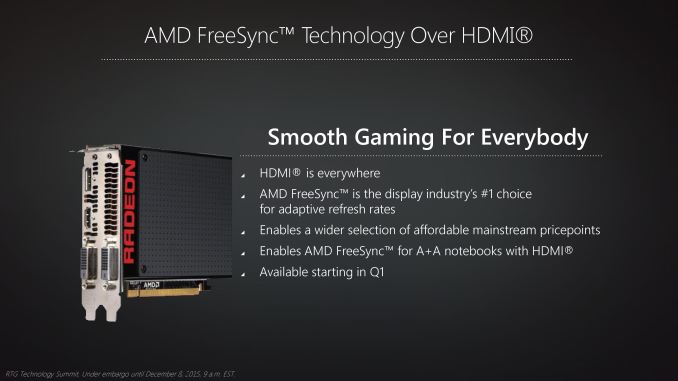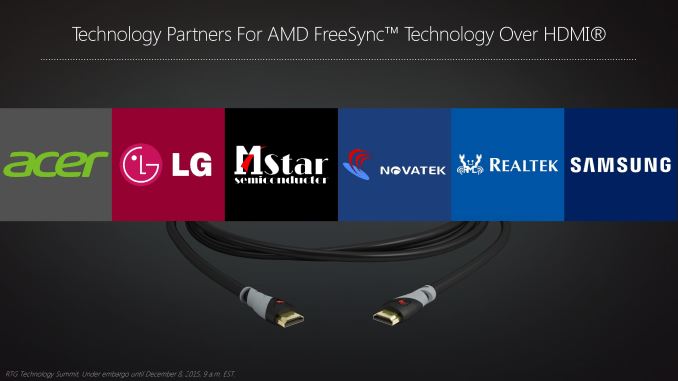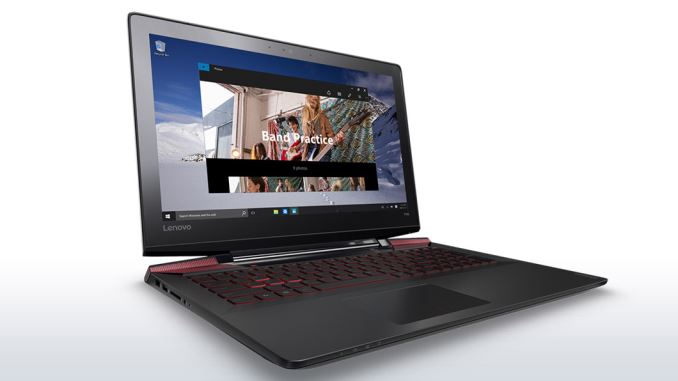AMD Discusses 2016 Radeon Visual Technologies Roadmap
by Ryan Smith on December 8, 2015 9:00 AM EST- Posted in
- GPUs
- Displays
- AMD
- Radeon
- DisplayPort
- HDMI
- Radeon Technologies Group
FreeSync Over HDMI to Hit Retail in Q1’16
After pushing DisplayPort Freesync out the door earlier this year, back at Computex 2015 AMD began demonstrating a further Freesync proof-of-concept implementation: FreeSync over HDMI.
Implemented over a customized version of HDMI 1.4a and utilizing a prototype Realtek timing controller (TCON), AMD was able to demonstrate variable refresh rate technology running over HDMI. At the time of the presentation AMD was very clear that the purpose of the presentation was to shop around the concept and to influence the various members of the HDMI consortium, but they were also clear that bringing variable refresh rate tech to HDMI was something the company wanted to bring to retail sooner than later.
Sooner, as it turns out, was the operative word there. As part of their presentation last week, RTG has announced that FreeSync over HDMI will be heading to retail, and that it will be doing so very soon: Q1’16. This is just a year after the first DisplayPort adaptive sync monitors hit retail, which for a display technology is a rather speedy turnaround from proof of concept to retail product.
Now there are some key technical differences from FreeSync over DisplayPort(FS-DP) that should be noted here. Unlike FS-DP, which was just AMD’s implementation of DisplayPort adaptive sync on their GPUs and software stack, FS-HDMI is not an open standard, at least not at this time. HDMI does not have a variable refresh rate technology standard, and while RTG is pushing to have one included in a future version of HDMI, the HDMI consortium moves too slowly for RTG’s tastes. As a result RTG is looking to go it alone, and will be implementing FS-HDMI by creating a vendor specific extension for HDMI.
The use of vendor specific extensions is perfectly legal within the HDMI standard, but it does mean that FS-HDMI is proprietary, at least until such a time where the HDMI standard adopts a common variable refresh rate standard. This means that FS-HDMI monitors will need to support RTG’s proprietary extensions, which in turn requires TCON/monitor vendors to work a bit more closely with RTG than was necessary with FS-DP. Meanwhile RTG for their part hasn’t yet decided what to do about the proprietary nature of their implementation – they are open to sharing it, but they also want to retain control and avoid any scenario that results in outright balkanization of HDMI variable refresh rate technology. The fact that it’s an RTG-controlled specification calls into question whether any other GPU vendor would want to implement it in the first place – so concerns about openness may prove to be moot – but it does mean that it’s going to be up to RTG to make or break FS-HDMI.
Perhaps more surprising, and certainly a feather in RTG’s cap, is that RTG has brought so many TCON vendors on-board so early. Along with Realtek, Novatek and Mstar will all be producing TCONs that support FS-HDMI, so TCONs will be available from multiple vendors relatively quickly. With variable refresh rate tech it’s the TCONs that really decide whether the tech is supported, so this is an important set of partnerships for RTG to lock in so soon. Meanwhile traditional AMD/RTG display partners such as Acer, LG, and Samsung will be producing retail monitors with FS-HDMI capabilities.
Meanwhile at this point RTG isn’t talking about GPU compatibility in great detail, however it sounds like FS-HDMI support will be brought over to some of RTG’s current GPUs. Most likely these are the GCN 1.1+ Radeon 300 series cards, with GCN 1.1 also being the minimum requirement for FS-DP. AMD’s Carrizo APU should also support the technology, and RTG is specifically promoting that notebooks implementing an APU + dGPU Radeon dual graphics configuration will also support FS-HDMI, an important development especially given the fact that DisplayPort support is non-existent on consumer AMD laptops.
In fact the lack of DisplayPort availability in displays overall is a big part of why RTG has pursued this. According to numbers from RTG, only about 30% of all monitors sold include a DisplayPort, while the other 70% are only implementing HDMI or HDMI + DVI. Consequently FS-DP is an inherently limited market and the majority of monitor buyers will never be able to use FS-DP. Meanwhile from what I hear the actual cost of implementing variable refresh rate support on a TCON is very low, which means that RTG could get far greater penetration for FreeSync by extending it to support HDMI, not to mention bringing down the overall cost of entry-level FreeSync monitors. We’re still talking about a highly price sensitive commodity market – after all, there’s a reason that most monitors don’t ship with a DisplayPort – but if the costs of adding FreeSync are as low as RTG hints, then there is a market for consumers who would spend a bit more on a variable refresh rate monitor but don’t know anything about display I/O standards beyond HDMI.
Finally, along those lines, it should be no surprise that the first FS-HDMI monitors that have been announced are all focused on lower cost and lower resolution displays. That FP-HDMI is being implemented over HDMI 1.4 immediately rules out 4K monitors, so instead all announced monitors are 1080p or ultra-wide 21:9 aspect ratio 2560x1080 and 3440x1440 monitors. Otherwise there are a few more unknowns here that I expect we’ll see addressed ahead of the Q1 launch, particularly which monitors will support a wide-enough range of rates for low framerate compensation to work.
FreeSync Laptops: Shipping Now
Along with the FreeSync over HDMI announcement, RTG also used their event to announce the first FreeSync-capable laptop, the Lenovo Y700. One of the models of the laptop ships with a variable refresh rate capable 15.6” 1080p IPS panel, and when paired up with a Carrizo APU and R9 M380 GPU, can utilize FreeSync to control the refresh rate. The one notable limitation here is that while this otherwise a rather typical DisplayPort adaptive sync setup within a laptop, the specific panel being used here is only supports a range of 40Hz to 60Hz, so the first FreeSync laptop has a narrow effective range and can’t support LFC.
















99 Comments
View All Comments
Michael Bay - Thursday, December 10, 2015 - link
He`s drunk or crazy. Typical state for AMD user.RussianSensation - Wednesday, December 23, 2015 - link
It's actually correct. GCN-like implies Pascal will be more oriented towards GPGPU/compute functions -- i.e., graphics cards are moving towards general purpose processing devices that are good at performing various parallel tasks well. GCN is just a marketing name but the main thing about it is focus on compute + graphics functionality. NV is re-focusing its efforts heavily on compute with Pascal. For example, they are aiming to increase neural network performance by 10X.extide - Tuesday, December 8, 2015 - link
While nVidia picks a new name for each generation it's not like they are tossing the old design in the trash and building an entirely new GPU ... I would imagine we will see "GCN 2.0" next year, and I would be surprised if better power efficiency was not one of the main features.Refuge - Tuesday, December 8, 2015 - link
That has been their trend for the last two Architecture updates they've made. Granted small adjustments, but all in the name of power and efficiency.Jon Irenicus - Tuesday, December 8, 2015 - link
Apparently in maxwell they got that power efficiency by stripping out a lot of the hardware schedules amd still has in gcn, so the efficiency boost and power decrease was not "free." It will mean that maxwell cards are less capable of context switching for VR, and can't handle mixed graphics/compute workloads as well as gcn cards. That was fine with dx11 and it worked well for them, but I don't think those cards will age well at all. But that may have been part of the point.haukionkannel - Tuesday, December 8, 2015 - link
They only need to upgrade some part of GCN and they are just fine!The Nvidia did very good job in compression architecture of their GPU and that lead much better energy usage because they can use smaller (and cheaper) memory pathway. (There are other factors too, but that one is guite important)
AMD have higher bandwidth version of their 380, but the card does not benefit from it, so they are not releasing it, because 380 also have relative good compression build in. Make it better, increase ROPs and GCN is competitive again.
WaltC - Tuesday, December 8, 2015 - link
Odd, considering that nVidia is very much in catch-up mode presently concerning HBM deployment and even D3d12 hardware compliance...;) But, I don't do mobile at all, so I can't see it from that *cough* perspective...Michael Bay - Thursday, December 10, 2015 - link
HBM does not offer any real advantage to the enduser presently, so there is literally no catch-up on nV part. Same with DX12.Macpoedel - Tuesday, December 8, 2015 - link
Nvidia changes the name of their architecture for every little change they make, that doesn't mean AMD has to do so as well. GCN 1.0 and GCN 1.2 are almost as much apart as Maxwell 2 and Kepler are. GPU architectures haven't changed all that much since both companies stated using the 28nm node.Frenetic Pony - Tuesday, December 8, 2015 - link
Supposedly next year will bring GCN 2.0 Also it's already confirmed that there's basically no architectural improvements from Nvidia next year. Pascal is almost identical to Maxwell in most ways except for a handful of compute features.